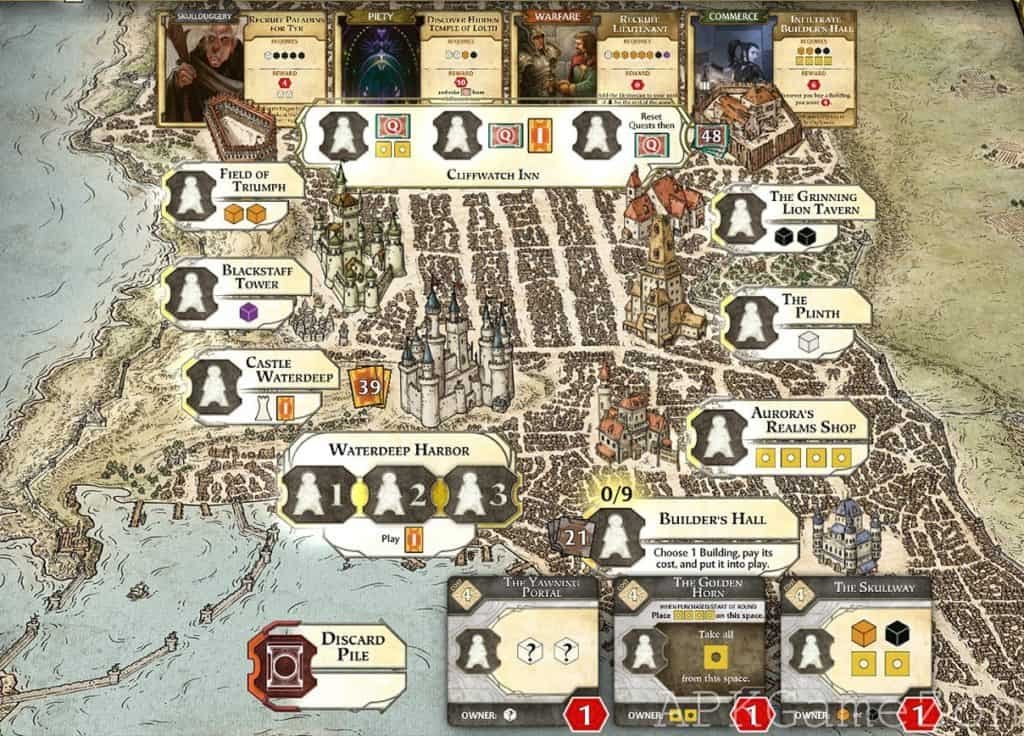When a budding writer wants to write a novel, they’ll study novels, and learn their underlying structure. It’s incredibly important to understand how those who came before you worked, so you can stand on their shoulders. When a musician wants to write music, they’ll listen to music, and learn its underlying structure for the same reason. And when a game designer wants to balance a board game, they should study board games, and you guessed it, study its underlying structure. If you want a game balance example, read on.
It’s hugely valuable to tear apart a game’s balance decisions, find the hidden strings that keep it all moving. However, some games are far too obtuse to easily figure out its structure. And This process can get pretty mathy, so I’m going to do the work for you: I’m going to write a series on games, and how they are balanced. To start this series I’m using a very simple game: Lords of Waterdeep. So first, if you’re not familiar with the game Lords of Waterdeep, familiarize yourself first. It’s a pretty easy game.
So how does it happen? How do designer’s approach balance?
There are as several ways to approach balancing a game. I’m only going to be talking about one of them today: finding a core unit, and valuing every resource/action/game component in the game relative to that unit.
The Core Unit for Balancing a Game
A core unit is any part of a game that you can measure the rest of the game against. In many dungeon crawlers, that unit is HP. In a hypothetical turn based dungeon crawl game with stats for defense, strength, magic, and hp, hp is the logical choice. Defense effects how quickly you lose HP. Strength effects how quickly they die, or in other words, how many times an enemy gets to hit you and lower your HP. Magic can be converted straight into HP with a heal spell, or effect your HP the same way strength does by changing the number of hits you have to take before combat ends.
In effect, you could make a formula: every stat boost is worth 5 hp against some standard difficulty enemy. You could balance items around the same sort of formula too. This same HP logic could be used to balance the pokemon games too.
You might be worried that this method is too simple, but players rarely notice the math underlying a game, and if a player is dedicated enough to figure it out, they’ll appreciate that at its core it’s simple, as it gives them a lot to work with strategically.
Game Balance Example: Lords of Waterdeep
In Lords of Waterdeep, the core unit is the action. One action, ie, one placement of your worker, is the lens through which everything is balanced.
Half an action is worth:
- one rogue
- one fighter
- half a cleric
- half a wizard
- two gold
- a quest card
- an intrigue card
Therefore, a balanced action space in the game can be assembled with any two of the above actions. A rogue and two gold, two fighters, a quest card and a rogue, etc.
With this simple formula, you can see how every space on the board is calculated.

Action Space balancing: Buildings
Now, the above formula doesn’t apply to everything in the game. Intrigue cards can break the formula, even the ones that just gain resources. Quests can break the formula too, sometimes.
Buildings can break that formula too, but for the most part, they follow it pretty strictly.
There are two kinds of buildings. Those that cost 3-4 money: these buildings give 1 to 1.5 actions to whoever takes it, and rewards the building’s owner with .5 actions worth of resources back. Then there are buildings that cost 7-8, that give 2 actions worth of resources to whoever takes it, and 1 full action worth of resources to whoever built it.
How did they arrive at these numbers? Well, for starters, in order to build a cheap building, it takes 2 actions: the money action, and the build action. In order for these buildings to break even on actions, they need to be used 4 times. If you built it on the first turn, and it’s used every turn, it will gain you 4 actions, 2 more than you spent on it.
For an expensive building, it takes 3 actions: the money action two times, then the build action. In order for these buildings to break even on actions, they only need to be used 3 times. If you built this as early as possible, the second turn, and it’s used every turn, then it gains you 7 actions, 4 more than you spent on it.
Buildings are balanced in such a way that there is a chance that it does not net you any actions at all, but they promise to reward you modestly over the course of a game.
Converting Actions to Points
Now, when calculating how many points a quest should be worth, Peter Lee and Rodney Thompson simply took the number of actions it takes to complete a quest, and multiplied that number by 4. If the quest is particularly difficult to do, multiply it by 5.
Plot quests generally score points equal to about the number of actions they take, so they are only worthwhile for a player who plans to use its ability.
An important thing to note about this, is that every adventurer is worth 1 point at the end of the game. If Quests weren’t significantly better than 1pt/adventurer, it’d be possible that the best strategy would be to just collect as many adventurers as possible, without wasting actions taking quest cards, or worrying about the harder-to-find clerics and wizards. That hypothetical situation would break the game in multiple ways.
Final Steps
Now, that’s really all there is to this game’s balance. Anything that doesn’t match these formulas exactly probably changed in playtesting. Lots of cards don’t match the formula, and that’s alright. The formula is there to give you an initial starting place.
Sometimes, cards are too powerful, even when they match the formula, and sometimes they are too weak. Sometimes, players perception of a card seeming to be too powerful or too weak is enough to warrant breaking your formula too.
When using this method yourself, remember that your formula might be wrong. Test several majorly different permeations and once one starts feeling good, start tweaking it in minor ways. The bigger the changes you make, the more confident you are that you’re going in the right direction. For example, if you double a value in your balancing formula, and it feels way worse, then you know it’s probably right to lower it. If you half it and it feels better, then you know the right value is lower than the initial value.
Conclusion
If you want to suggest the next game in this series, I’d be happy to hear it.
Thanks for reading.



Interesting thoughts. Did you talk with the designers or is this a sort of reverse engineering? I’m think of all the games I’ve played and trying to pick out the core value and see how well this applies.
It also gave me a lot to work with in analyzing whats bugging me with my design thanks for the insight.
An analysis of something like Settlers of Catan or Ticket To Ride would be interesting.
This is a reverse engineering.
Interestingly enough, settlers would be almost impossible to analyze like this, since the rarity of each resource changes from game to game, and since its a trading game, its worth is decided by the players. It’s what I’d call a “self balancing game.” Any distribution of resources would work, it’d just change how players trade.